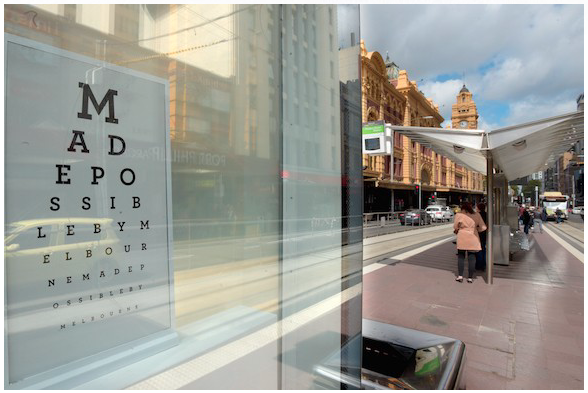Taking Melbourne’s research impact to the streets

The impact of the University of Melbourne’s research will be on full display this month as part of a landmark public exhibition on the streets of Melbourne’s CBD.
From rice that could improve half the world’s diet to breakthroughs that could save the lives of a thousand babies, the free Made Possible By Melbourne exhibition will feature interactive exhibits on Melbourne’s iconic Flinders, Collins and Spencer Streets.
Among the installations on display, visitors will be able to:
- See how much water goes into producing one corncob
- Experience what it's like to lose sight from blinding eye diseases such as Trachoma, and
- Light up the central nervous system to learn about growing brains outside the body.
The exhibits will be found on tram stops throughout the CBD.
A downloadable audio guide narrated by Australian broadcaster and Melbourne alumna Libbi Gorr, in conversation with University researchers, will guide visitors through the exhibits. Long-form stories that go behind the scenes of the research will be available on the University’s publishing platform, Pursuit.
The exhibition will be launched at City Square on November 2-3 with the ‘World-Changing Cafeteria’ which showcases two of the 14 research stories featured in the exhibition; on the University’s work into water efficiency programs and how iron-enriched rice can help to solve ‘hidden hunger’. The City Square site will also serve as a kick-off point for people to grab a map and take the Made Possible by Melbourne tour.
Made Possible By Melbourne is the University’s follow-up to its award-winning 2015 Collision campaign. The campaign aims to provide Melburnians with a tangible display of the world-changing research conducted at the University and the impact it can have on them.
University of Melbourne Vice-Chancellor Glyn Davis said the campaign would provide a unique opportunity for people to get up close and personal with the University’s research activities.
“As a comprehensive, research-intensive and globally engaged university, the University is committed to sharing advances that shape the world with the wider community," Professor Davis said.
"However, like many universities, the challenge remains in how we ensure the widest possible audience connects with and understands our research impact.
“Melbourne is widely regarded as Australia’s cultural capital, so in offering up a public exhibition of the artefacts that tell the story of the University’s research outcomes, we believe that Melburnians and visitors from around the world will be truly moved by the scale of what we continue to achieve.”
University of Melbourne Marketing and Communications Executive Director Lara McKay said the exhibition was about reaching out to people in a new and innovative way.
“We know that many in the wider community do not realize the scale and impact of the research that the University undertakes," she said.
"However we also understand that Melbournians lead busy lives and university research is not on their radar, so we need to be creative in how we attract attention to our research output and how it can benefit them or those they care about.”
A suite of outdoor, digital and cinema advertising will support the exhibition during its run from 31 October to 25 November.
The exhibition was produced in conjunction with McCann.